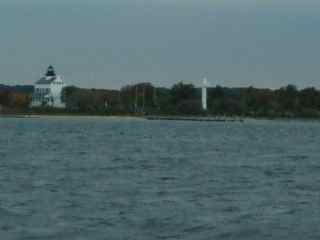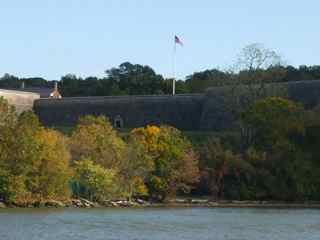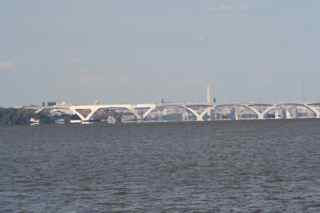This was only a four hour-trip. We did get to see the Thomas Point Lighthouse; which is the oldest manned light house on the Chesapeake.

The Harness creek was very busy creek but got quiet at night and only had a few boats join us in the creek for the evening rest. We all went out for a kayak ride down the creek. There is a small area just around the corner from where we anchored that is called "Hurricane Hole". There are many places as we travel that the locals find and name these areas "Hurricane Hole".

These areas are very important to cruisers like us and to boats like Gypsies. If needed we would be able to anchor in and be very safe if a hurricane came up the coast with its strong rain, gusting winds and ferocious seas. Luckily we had had only one hurricane Gypsies had to be careful of and that was hurricane or tropical storm Hannah when we were in Rhode Island. We couldn't find a hurricane hole there but we where able to tie Gypsies down well enough to survive the storm anyway. On our kayak ride we saw many blue herons again, but what was different is that this herons in the creek were not as afraid of humans as in the past creeks we've visited.

The next morning we got up bright and early to take a six hour cruise to another river that is on the west side of the Chesapeake Bay named the Patuxent River and to another anchoring creek called St. Leonard Creek. On this morning we saw the most beautiful sunrise any of us had ever seen. The sun was bright red and lite up the sky so pretty it was breath taking.

The St. leanord creek is most famous for a battle that occurred during the war of 1812; I'm starting to think that the whole war of 1812 was fought in the Chesapeake Bay but I know that isn't entirely true, anyway here in this creek a small gun boat called a Flotilla commanded by "Commodore Barney was butted up in St. Leonard Creek in the Patuxent River when a fleet of British came up the river on the way to DC. The small boat had surprised the British fleet and turned them back. A great victory for a little guys! Unfortunately, the British came back with reinforcements and the gun boat was scuttled and the British went on to burn Washington, DC.
Our next stop is a 1/3 of the ways up the Potomac River that eventually brings us to Washington, DC.This time we go into a bay off the Potomac River called St. Clements Bay and into Canoe Neck Creek. This creek wasn't our first choice but this creek seemed more protected from the winds than the first creek Tammy found. It was very cold and a little late so we just stayed in for the night and rested up for our ten-hour cruise the next day into Washington, DC.
As we left St. Clements Bay and back into the Potomac we went by St. Clements Island. On the Island was a very large cross erected on the southern tip that was very big and we could see it from the boat as we went by. This cross was put up by the original colonist who founded the island in 1634. They traveled in two boats called the "Ark" and the "Dove" giving thanks to the gods for their safe voyage across the Atlantic Ocean. The original cross was replaced by a new stone cross in 1934.

The last leg of our trip to DC was another ten-hour trip. This part of the trip was very entertaining, the upper end of the Potomac River is Mount Vernon. Can you tell me what president lived here?...which number president he was?

We also went by an old fort called Fort Washington.

As we came into DC we went under the Woodrow Wilson Memorial Bridge and we can just start to see the Washington Monument and the Jefferson Memorial.

We also saw something in the river that none of us have seen before, a small boat capsized and a police boat towing it. We all hope the people that were in it are all OK!

Well we made it to our slip and are able to dock before 5:00pm. Again it is still cold out so we stay in and plan our day for our walk about DC the next day. The District of Columbia is an incredible place that every American should visit at least a few times in their lives. This is where the history of our country is all documented and has many many memorials of our forefathers that worked so very hard to give as all this great nation we live in. It also has many memorials of the men and women who fought and sacrificed to preserve democracy throughout our nation's history. We tried to go to as many places as possible in the two days we were to spend there, but we would need at least a week to see it all.
There is so much history here that it would be easy to ask lots of questions for all of you for homework. But it wouldn't make for a very good blog , so I am going to tell you about our two days and only ask you a few questions. All I ask of you is that you bug your parents to take you here some day. Here we go...
We stared in the heart of DC at the Washington Monument

to a place they call the "Mall".

The Washington Monument is a very tall thin structure that can be seen from almost anywhere in DC. From there we walked straight down to the War World II Memorial that is extremely beautiful.

This is a memorial for all that served in that war. It also has stuctures that represented all the states that participated in the war.


Next we headed to the Refection Pool that stretches across the mall area.

People are not allowed to swim in it but some ducks had some fun finding food at the bottom of the Reflection Pool.

We follow this walkway up to the Lincoln Memorial.

This memorial is for our 16th President of the United States. President Lincoln was in office during 1861 until he was shot by an assassin on April 14, 1865. During his presidency the Civil War had stared mostly because President Lincoln wanted to end slavery in the southern part of the country. In January 1863 Lincoln issued the Emancipation Procalamtion to free the slaves, thus raising the war to a higher moral plane. On March 4, 1865, President Lincoln offered peace and reconciliation to the South. The day after he was shot the commander of the south, General Robert E. Lee surrendered his troops and the slaves where freed. A very brave and honest man, "Honest Abe" was his nic name.

Besides freeing the slaves he also wrote the Gettysburg Address and preserved the Union. He did many many more great things in his life before his death but soon you will learn it all in school, well off to the next memorial.
The next two memorials are for two wars, the Vietnam War and the Korean War. The Vietnam veterans Memorial is a very long wall with all of the names of all who died or are still missing in the order we lost them in the war.

To the many veterans and their loved ones, the healing process often involved leaving mementos at the wall. There are two other sculptures that are part of the Vietnam Memorial. One is of the men who served in the war

and the other is of the women who served and gave their lives.

This war was not a very popular war but the memorial was built to honor those who lost their lives, not by making any political statement about the war.
The Korean War Veterans Memorial honors those Americans who answered the call, those who worked and fought under the most tying of circumstances, and those who gave their lives for the cause of freedom.

From 1950 to 1953 the United States joined the United Nations forces in Korean to take a stand against what was deemed a threat to democratic nations worldwide. As the war ended many in this country were reluctant to view the Korean War as something to memorialize. But to the men and women who served, the Korean War could never be a forgotten war.

This memorial was made to reflect the true tragety of war with many sculptures of men in battle reflecting off a wall that has the faces of the men and women who served. A very striking and heart touching memorial.

Next we went around the Tidal Basin

to the Franklin Delano Roosevelt Memorial. Franklin D. Roosevelt was our 32nd president of the United States.

He was elected to four terms (before the two-term limit was established) in 1944 but dies after one year into his fourth term in office. President Roosevelt (aka FDR) was elected president during the Great Depression and World War II. Those twelve years in term where 12 years of personal struggle and triumphs. There is a sculpure in his memorial that shows men in the 1930's waiting in line for bread.

The looks on their faces emphasize the struggle of the times and the literal and figurative hunger that many Americans felt during the Depression. FRD contracted polio at he age of 39 and never walked another step without assistance. He spend each day of his 12-year presidency in a wheelchair. One of the nation's greatest leaders, FDR's determination and courage remain an inspiration for people around the world, especially for those with disabilities. His two loves were his wife Elenor; who was famous in her own right,

and his beloved dog Fala.

Both have statues of themselves as part of the memorial to FRD.
Next we headed off to see another great man's memorial, Thomas Jefferson, the principle author of the Declaration of Independence.

Can you tell me on what day of the year that was signed? Can you name any of the other people who signed it? Thomas Jefferson was also a political philosopher, architect, musician, book collector, scientist, horticulturist, diplomat, inventer, and third President of the United States. Thomas Jefferson lomes large in any discusion of who Americans are as a people.

Jefferson left to the future not only ideas but a great body of practical achievements. President John F. Kennedy recognized Jefferson's accomplishments when he told a gathering of American Nobel Peace Prize winners that they were the greatest assembly of talent in the White house since Jefferson had dined there alone; that shows how powerful and respected Jefferson was.

Last stop of the day was the United States Holocaust Museum.

This is a museum that deplicts the worst destruction of human life by Nazi Germany and its collaborators between 1933 and 1945 through World War II. Jews were the primary victims-six million were murdered. Roma Gypsies (not our boat), people with disabilities, and Poles (people from Poland), were also targeted for destruction or decimation for racial, ethnic or national reasons. Millions more, including homosexuals, Jehovah's witnesses, soviet prisoners of war, and political dissidents, also suffered grievous oppression and death under Nazi tyranny. Every human being should see what lies behind the walls of this museum. The pictures and stories should never be forgotten.
The next day we spent at the Arlington National Cemetery. This is the Cemetery that shelters veterans from every war that has
involved our nation. Over 320,000 servicemen and their family members rest on the 624 acres of Virginia land across the Potomac River from the Lincoln Memorial. About 27 burials are conducted every week.

We first went to visit the grave of President John F. Kennedy along with his wife and children with Cape Code stones framing
the eternal flame.

Next we visited the John F. Kennedy's brother grave Robert F. Kennedy.

Both were assasinated. John during his office as President and Robert while campaigning for the presidency.
Next we went up a big hill to the Arlington House.

The house that Robert E. Lee and his family lived in. It is in the process of being restored as a memorial for Robert E. Lee.
We then went across the cemetery to watch the timeless ritual at the Tomb of the Unknowns. Here a sentinel of the third US. Infantry maintains the vigil around the clock. The sentinel paces 21 steps down the mat before the tomb, pauses 21 seconds, and returns.

Every hour they change the guard known as the "changing of the guard".

We then move across the grounds to The Memorial Amphitheater, one of the most visited sections in Arlington national Cemetery, is now the setting for these observances.

Flags bedeck the circle of arches around marble benches and potium where leaders pay tribute to those who served.

Next we went to see the memorial for the crew of both the Challenger and the Colombia.

Both vessels never made it home. Can you name the women from NH who was part of that crew from the Challenger?

Last we went to see the mast of the USS Maine that sunk in Havana Harbor because Doug and Tammy lived in Maine and we are on a boat.

It was a great ending to two wonderful days sightseeing in DC. The entire place was very beautiful with lots of pretty flowers and green green grass.

It is a great place to rest our fallen soldiers and the amazing people who have served this great country.
We went into China Town in DC for dinner and then headed home to Gypsies to get us ready to leave early to travel back down the Potomac for more adventures. Until then...may your nose and toes always be warm.
No comments:
Post a Comment